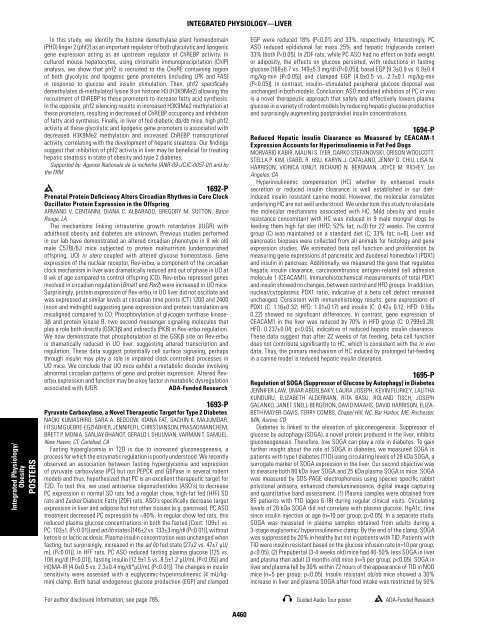2011 ADA Posters 1261-2041.indd - Diabetes
2011 ADA Posters 1261-2041.indd - Diabetes
2011 ADA Posters 1261-2041.indd - Diabetes
You also want an ePaper? Increase the reach of your titles
YUMPU automatically turns print PDFs into web optimized ePapers that Google loves.
Integrated Physiology/<br />
Obesity<br />
POSTERS<br />
In this study, we identify the histone demethylase plant homeodomain<br />
(PHD) fi nger 2 (phf2) as an important regulator of both glycolytic and lipogenic<br />
gene expression acting as an upstream regulator of ChREBP activity. In<br />
cultured mouse hepatocytes, using chromatin immunoprecipitation (ChIP)<br />
analysis, we show that phf2 is recruited to the ChoRE containing region<br />
of both glycolytic and lipogenic gene promoters (including LPK and FAS)<br />
in response to glucose and insulin stimulation. Then, phf2 specifi cally<br />
demethylates di-methylated lysine 9 on histone H3 (H3K9Me2) allowing the<br />
recruitment of ChREBP to these promoters to increase fatty acid synthesis.<br />
In the opposite, phf2 silencing results in increased H3K9Me2 methylation at<br />
these promoters, resulting in decreased of ChREBP occupancy and inhibition<br />
of fatty acid synthesis. Finally, in liver of fed diabetic db/db mice, high phf2<br />
activity at these glycolytic and lipogenic gene promoters is associated with<br />
decreased H3K9Me2 methylation and increased ChREBP transcriptional<br />
activity, correlating with the development of hepatic steatosis. Our fi ndings<br />
suggest that inhibition of phf2 activity in liver may be benefi cial for treating<br />
hepatic steatosis in state of obesity and type 2 diabetes.<br />
Supported by: Agence Nationale de la recherhe (ANR-09-JCJC-0057-01) and by<br />
the FRM<br />
1692-P<br />
Prenatal Protein Defi ciency Alters Circadian Rhythms in Core Clock<br />
Oscillator Protein Expression in the Offspring<br />
ARMAND V. CENTANNI, DIANA C. ALBARADO, GREGORY M. SUTTON, Baton<br />
Rouge, LA<br />
The mechanisms linking intrauterine growth retardation (IUGR) with<br />
adulthood obesity and diabetes are unknown. Previous studies performed<br />
in our lab have demonstrated an altered circadian phenotype in 8 wk old<br />
male C57Bl/6J mice subjected to protein malnutrition (undernourished<br />
offspring, UO) in utero coupled with altered glucose homeostasis. Gene<br />
expression of the nuclear receptor, Rev-erbα, a component of the circadian<br />
clock mechanism in liver was dramatically reduced and out of phase in UO at<br />
8 wk of age compared to control offspring (CO). Rev-erbα repressed genes<br />
involved in circadian regulation (Bmal1 and Per2) were increased in UO mice.<br />
Surprisingly, protein expression of Rev-erbα in UO liver did not oscillate and<br />
was expressed at similar levels at circadian time points (CT) 1200 and 2400<br />
(noon and midnight) suggesting gene expression and protein translation are<br />
misaligned compared to CO. Phosphorylation of glycogen synthase kinase-<br />
3β and protein kinase B, two second messenger signaling molecules that<br />
play a role both directly (GSK3β) and indirectly (PKB) in Rev-erbα regulation.<br />
We now demonstrate that phosphorylation at the GSKβ site on Rev-erbα<br />
is dramatically reduced in UO liver, suggesting altered transcription and<br />
regulation. These data suggest potentially cell surface signaling, perhaps<br />
through insulin may play a role in impaired clock controlled processes in<br />
UO mice. We conclude that UO mice exhibit a metabolic disorder involving<br />
abnormal circadian patterns of gene and protein expression. Altered Reverbα<br />
expression and function may be a key factor in metabolic dysregulation<br />
associated with IUGR. <strong>ADA</strong>-Funded Research<br />
1693-P<br />
Pyruvate Carboxylase, a Novel Therapeutic Target for Type 2 <strong>Diabetes</strong><br />
NAOKI KUMASHIRO, SARA A. BEDDOW, IOANA FAT, SACHIN K. MAJUMDAR,<br />
FITSUM GUEBRE-EGZIABHER, JENNIFER L. CHRISTIANSON, PRASAD MANCHEM,<br />
BRETT P. MONIA, SANJAY BHANOT, GERALD I. SHULMAN, VARMAN T. SAMUEL,<br />
New Haven, CT, Carlsbad, CA<br />
Fasting hyperglycemia in T2D is due to increased gluconeogenesis, a<br />
process for which the enzymatic regulation is poorly understood. We recently<br />
observed an association between fasting hyperglycemia and expression<br />
of pyruvate carboxylase (PC) but not PEPCK and G6Pase in several rodent<br />
models and thus, hypothesized that PC is an excellent therapeutic target for<br />
T2D. To test this, we used antisense oligonucleotides (ASO’s) to decrease<br />
PC expression in normal SD rats fed a regular chow, high-fat fed (HFF) SD<br />
rats and Zucker Diabetic Fatty (ZDF) rats. ASO’s specifi cally decrease target<br />
expression in liver and adipose but not other tissues (e.g. pancreas). PC ASO<br />
treatment decreased PC expression by ∼90%. In regular chow fed rats, this<br />
reduced plasma glucose concentrations in both the fasted [Cont: 109±1 vs.<br />
PC: 103±1, (P
















